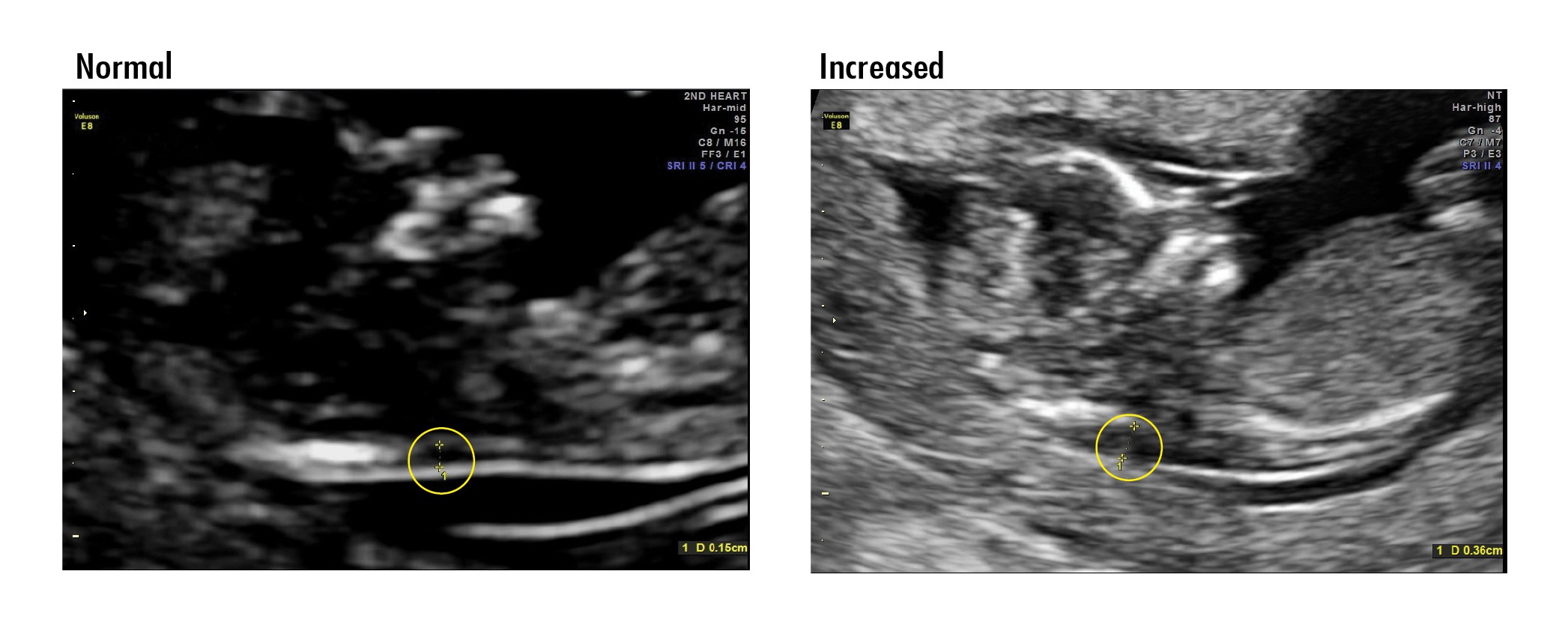Increased Nuchal Translucency
If you had a nuchal translucency (NT) ultrasound in the first trimester of pregnancy, it is important to understand what it means if the measurement is “increased” or “abnormal”.
What is an Increased NT?
It is a normal part of development for every baby to have some fluid at the back of the neck at this time. This pocket of fluid is also called the nuchal translucency (NT). When there is an increased amount of fluid from what we typically see, there is a higher chance for the baby to have a genetic condition or another difference in how the baby grows and develops.
In Ontario, the cut-off for the NT measurement to be considered “increased” is 3.5 mm. If the measurement is 3.5 mm or higher, your health-care practitioner should offer you an appointment to a specialist in genetics to discuss the results of the ultrasound in detail, and your options for further testing.
This appointment should be offered even if you had "screen negative" or "low risk" results from enhanced First Trimester Screening (eFTS) or Non-Invasive Prenatal Testing (NIPT).

First image: ultrasound showing a "normal" nuchal translucency measurement (less than 3.5 mm). Second image: ultrasound showing an increased nuchal translucency measurement (3.5 mm or more).
Illustration adapted from Genetic Counseling Aids, 7th Edition, Copyright 2020, permission for use granted by Greenwood Genetic Center.
What an Increased NT Measurement Could Mean
When there is an increased NT measurement, it is important to remember that it does not mean that for sure there is a genetic difference or other differences in how the baby is growing or developing.
Many babies with an Increased NT measurement are born healthy
When there is an increased NT measurement, there is a higher chance for the baby to have:
- a chromosome difference, such as trisomy 21 (Down syndrome) and trisomy 18 (Edwards syndrome).
- other genetic conditions, such as a condition called Noonan syndrome.
- physical differences, such as a heart defect, or a problem with the growth of the bones.
When there is an increased NT measurement, the pocket of fluid will most likely disappear and will no longer be seen in future ultrasounds. If the pocket of fluid disappears, it does not take away the chance for the baby to have one the above differences.
It is also possible that the pocket of fluid will remain about the same or will increase even more. In some cases, there will be build-up of fluid seen in at least two other parts of the body (such as lungs or under the skin). When this happens, it can be a life-threatening situation regardless of what the underlying reason is.
Next Steps
The genetics specialist will discuss your result in detail, provide support, and review options for more testing. These may include:
| Diagnostic testing |
|
Diagnostic testing (usually through chorionic villus sampling or amniocentesis) is the only way you can know for sure if your baby has a chromosome difference during the pregnancy. Diagnostic testing may also include testing for Noonan syndrome. If you do not wish to have diagnostic testing in pregnancy, a diagnostic test may still be done after birth to learn if the baby has a chromosome difference or other genetic conditions. This testing is done through a sample from the cord blood at birth, or through a regular blood sample from the baby. |
| Non-Invasive Prenatal Testing |
| Non-Invasive Prenatal Testing is funded by OHIP when the NT measurement is increased. Keep in mind that NIPT does not look at as many genetic conditions as a diagnostic test (even if your NIPT includes screening for microdeletion syndromes), and the information from NIPT is not definitive. |
| Detailed Anatomy Ultrasound |
| A detailed anatomy ultrasound checks how the baby is growing and developing and can be done at 18-22 weeks of pregnancy, or earlier, depending on genetics centre and how far along you are in the pregnancy. This ultrasound can give you more information; however, a normal ultrasound does not mean the baby has no genetic conditions. |
| Fetal Echocardiogram (specialized ultrasound of the baby's heart) |
| A fetal echocardiogram checks the structures of the baby's heart and how it is working. This can be done at 18-22 weeks of pregnancy, or earlier, depending on genetics centre and how far along you are in the pregnancy. |
If the above testing is all normal, by far the majority of babies will be born healthy. It is important to remember that no test can look at "everything", and the birth of a baby without any health concerns can never be guaranteed.


 Subscribe to this page
Subscribe to this page